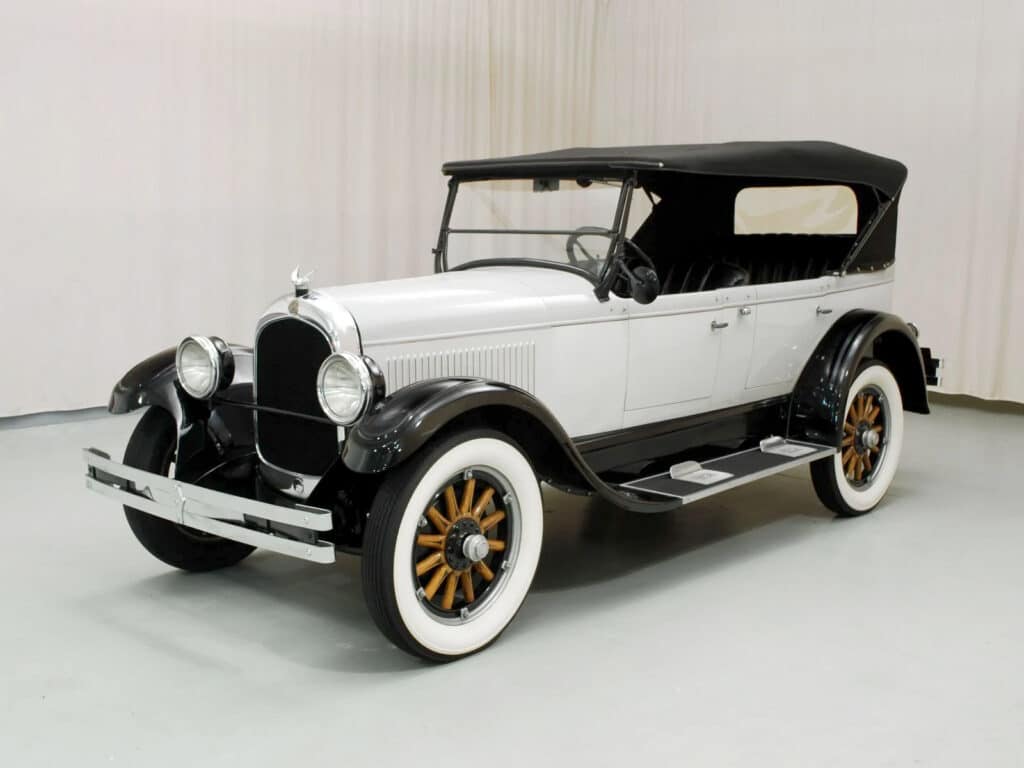By Maxine Carter-Lome, publisher
Behind every major company and brand launched in the early decades of the 20th century was an innovator with a vision. Nineteen twenty-five saw more than its share of visionaries; men and women who started new companies, introduced new, innovative products, and established brands that today, 100 years later, continue to revolutionize and dominate in their market. Here’s a little background on how some of these long-surviving companies got their start:
Benjamin Leroy Holt, C.L. Best, and Caterpillar®
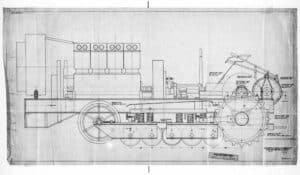
One hundred years ago this year, the Caterpillar Tractor Co. was formed from the merger of two companies: The C.L. Best Tractor Co., founded by Clarence Leo Best, and The Holt Manufacturing Company, founded in 1890 by Benjamin Leroy Holt.
Holt’s industrial roots came from his work with steam tractor machines. Starting in 1890, Holt built his first experimental steam traction engine, nicknamed “Old Betsy,” and followed that up with a steam-driven tractor capable of hauling 50 short tons of freight at 3mph. Because the steam tractors of the 1890s and early 1900s were extremely heavy – sometimes weighing 1,000 pounds (450 kg) per horsepower, and often sinking into the earth – Holt attempted to fix the problem over the years with various innovative ideas.
On Thanksgiving Day, November 24, 1904, the Holt steamer, No. 77, with a continuous track that kept the wheels from sinking into the mud, was successfully tested. As the story goes, company photographer Charles Clements, looking at the machine’s upside-down image through his camera lens, commented that the track rising and falling over the carrier rollers looked like a caterpillar, and Holt seized on the metaphor. “Caterpillar it is. That’s the name for it!”
Holt had a unique way of inventing – he did not work with traditional engineering tools or set design processes. He pretty much worked alone on the things that he did and never bothered to make complete design layouts or detailed drawings of his inventions. Instead, he envisioned every detail of his idea and instructed his pattern makers and machinists on how he wanted his ideas to be made. The only drawings were sketches provided to the pattern maker to make the original pattern for castings. Holt, known as “Uncle Ben” in the town where he lived (Stockton, California), was an old-style engineer, who worked from an idea in his head, which he conveyed to people who worked directly for him. By the end of his life in 1920, Holt owned over 45 different patents.
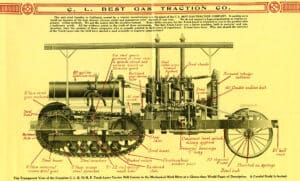
Clarence Leo Best, called Leo by his friends, was the founder of a small startup called the C.L. Best Gas Traction Co. He focused his initial efforts on building round-wheel tractors, but within a few months, he began working on a new track-type tractor design.
His first design attempt, called a ball-race tractor, was abandoned after building only one prototype in March 1911. Best persevered and by the end of 1912, his new track-type tractor, called the C.L. Best 70 Tracklayer, was ready to go into production. It was the first of Best’s tractors to have a Best-designed engine.
When the two companies, noted rivals while Holt was alive, merged to form Caterpillar in 1925, Best served as the Company’s first Chairman and took a large role in producing its first diesel engine.
Today, Caterpillar Tractor Co. is the world’s largest manufacturer of construction equipment, with 2023 sales and revenues of $67.1 billion. Its single largest customer is the U.S. government.
“CAT,” the company’s informal brand name, can not only be found on heavy equipment but on apparel, everything from outerwear to workwear to footwear.
Walter Percy Chrysler & Chrysler Corporation
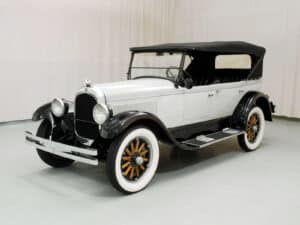
pressure engine lubrication. No wonder Chrysler sold 32,000 of them in its first year.
Walter Percy Chrysler was an American industrial pioneer in the automotive industry and the founder of and namesake for the American Chrysler Corporation.
Kansas-born Chrysler, the son of a locomotive engineer, was connected to the transportation industries throughout his life. His love of machinery prompted him to forsake a college
education for a machinist’s apprenticeship at the age of 17 in 1892. He then spent the next 20 years working his way up the echelons of railroad engineering, developing a reputation for his creative mechanical mind and his tireless enthusiasm.
Chrysler did not enter the automobile business until 1911 when he was 36 years old and met Charles Nash, then president of General Motors (GM). Nash persuaded him to join GM as the manager of the Buick plant in Flint, Michigan. Then in 1915, GM Founder William (“Billy”) Durant made him president of Buick.
Durant and Chrysler did not always see eye-to-eye on business matters and a year later, Chrysler left Buick and went to work for Maxwell Motors, with a vision to create an advanced, well-engineered car at an affordable price.
At the time, Maxwell was an ailing company, drowning in debt. Chrysler set about reviving it, introducing the Chrysler Six in January 1924 during the New York Automobile Show. The genius of Chrysler’s new car was not only its advanced engine technology and its stylish appearance but also its price point: under $2,000, an affordable price for the average American. Chrysler sold over 32,000 units of the Chrysler Six in its first year and The Maxwell company soon had a new name: Chrysler Corporation. In 1925, the firm boasted more than 3,800 dealers, sold over 100,000 cars and ranked fifth in the industry.
In 1928 Chrysler purchased Dodge Brothers, Inc., and later that year introduced the first Plymouth model to compete with modestly priced Fords and Chevrolets. The corporation became a major company in the American automotive industry, and Chrysler was named TIME magazine’s 1928 Man of the Year. He was riding high that year, as the Chrysler Corporation entered the top tier of American automaking, alongside General Motors and the Ford Motor Company.
Not content just to build iconic automobiles, Chrysler turned his attention to the erection of an iconic building. Between 1928 and 1930 he supervised the construction of the Chrysler Building, a striking Art Deco skyscraper, 77 stories high, on the corner of Lexington Avenue and 42nd Street in New York City.
Chrysler retired as president of his company in 1935, though he stayed on as chairman of the board until he died in 1940.
Giuseppe Uddo, Vincent Taormina, and Progresso
“Make it Progresso or Make it Yourself”
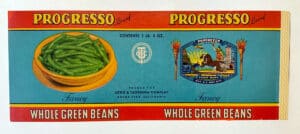
In the late 19th century, the burgeoning Italian community in New Orleans, Louisiana, clamored for tomato paste, anchovies, cheeses, and other products that only their homeland could supply. Sicilian importers like Giuseppe Uddo and Vincent Taormina, founders of Progresso Foods, responded to this craving.
The eldest of six children, Giuseppe (Joseph) grew up in Salemi, a small Sicilian village twenty-five miles from the Mediterranean. After the third grade, he quit school to help support his family. The nine-year-old drove a horse-drawn cart selling olives and cheeses in Salemi and nearby towns. Giuseppe was a venditor (street purveyor), a traditional Sicilian vocation.
On one of his many trips, Uddo met Vincent Taormina, a successful food merchant with many relatives in New Orleans. Taormina introduced the 24-year-old Uddo to his daughter, Eleanora, and the two married and emigrated to America in 1907 to start a new life.
Uddo quickly discovered there was no way to get the tasty Italian ingredients he grew up with, so he started a small business importing tomato paste and olives, bringing some of his favorite flavors to his new home in New Orleans.
According to his granddaughter Adele Uddo, Giuseppe bought his first cans of tomato paste from Jacob Cusamino, a merchant on Chartres St. who sold Giuseppe the rusty cans he typically discarded. Giuseppe brought the rusty cans back to his small apartment, which was described as “hot enough to melt candles” – there Eleanora found a loose brick in the courtyard and pounded it into a fine powder. She added a solution of lye and worked long into the night, scrubbing the cans and restoring their shiny finish. A plain white label was then placed around the can, which simply read: Progresso, supposedly based on a pastel painting Giuseppe Uddo had bought for $150 many years before at the Progress Grocery in the French Market. Drawn by one of the brothers who owned the shop, it portrayed “progress” through the rise of new forms of transportation. The symbol of improvement appealed to new and older Americans alike.
Having the same name as the most popular Italian-American newspaper, Il Progresso, also made it attractive to the many Italian immigrants.
Just before World War I, Uddo took out a loan and imported three thousand cases of tomato paste from his father-in-law Vincent to sell to markets and restaurants. When an embargo closed Italian ports, sales boomed and the two merged their businesses to form the Uddo-Taormina Company. But if the war taught them anything, it was their business could not depend on imports, so the company expanded U.S. operations with a factory in Vineland, New Jersey, in the heartland of Italian farmers, where workers canned and bottled roasted red peppers, sweet fried peppers, pepper salad, hot cherry peppers, tomato sauce, crushed tomatoes, tomato puree, and other products.After the war, the Vineland plant started turning out the country’s earliest ready-to-serve soups: this was the beginning of Progresso soups. From soups, they moved to beans, another peasant mainstay. A novelty for many Americans, they were a meal to the Italians. Fava beans, another favorite of the ancient Romans, became a filling dish after being mashed, mixed with greens, and dressed with olive oil. Cannellini, pinto, chickpeas, and black beans were soon added to their product line.
As shoppers became less fearful of ethnic foods, Progresso moved from Italian delis, markets, and restaurants to supermarket shelves in the late 1940s, forever changing Americans’ diets.
Following Uddo’s death in 1957, controversies arose between the Uddo and Taormina clans over control of the company. Eventually, was sold to Imperial Tobacco, a Canadian company in 1969, then to Pillsbury in 1995. In 2001, General Mills acquired Pillsbury.
Today, well over a century since Giuseppe Uddo rolled his cart of olives and cheeses through Sicilian villages, the business he created continues to deliver homestyle soups and Italian ingredients to families across the nation.
Shalimar
“A good perfume is one whose scent corresponds to an initial dream” – Jacques Guerlain
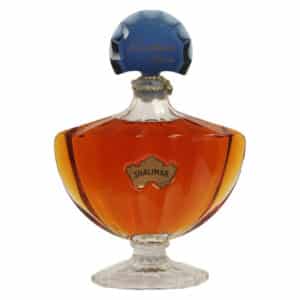
Shalimar is one of the most recognizable names and scents in the fragrance world and has been in continuous production since 1925. This perfume was created by French Perfumer Jacques Guerlain in 1921 for his family’s French perfume and cosmetics house, Guerlain. Jacques named his new fragrance, with its vanilla and citrus notes and oriental essence, Shalimar after the enchanting and marvelous Indian gardens of Shalimar in the north of India, in Pakistan. The name Shalimar means “temple of love” in Sanskrit.
Luca Turin and Tania Sanchez, authors of Perfumes: The A-Z Guide describe Shalimar’s scent as: “Deceptively simple,” “extraordinary,” “a vanillic amber with exceptional reach” and as evocative of “an evening in Paris” as “catching a glimpse of the Eiffel Tower lit up for New Year’s.”
As distinct as its scent, is Shalimar’s now iconic bottle, designed by Raymond Guerlain and manufactured by Baccarat Crystal; its shape is modeled after the basins of eastern gardens and Mongolian stupa art. The bottle won first prize at the Exhibition of Decorative Arts and Modern Industry in 1925 and is noted as the first footed bottle in the history of perfumery.
At the time, the bottle’s highly recognizable blue, fan-shaped bottle topper in the shape of a ventaille was a real revolution in the world of perfumery; Shalimar was the first bottle with a
colored cap. The bottle’s label was inspired by the engraved designs on the pristine white walls of the Taj Mahal. In fact, the shape of the label inspired the shape of the bottle for the eau de toilette and eau de parfum.
Shalimar extrait de parfum continues to be sold in its original Baccarat crystal bottle with blue glass stopper but was also copied and used by the glass houses of Cristal Romesnil and Pochet et du Courval for Shalimar in future design iterations.
During the 1920s, Shalimar was popular with flappers which helped give it a “bad girl” reputation. It was said that “a lady didn’t do three things: smoke, dance the tango, and wear Shalimar.” Louise Brooks, Rita Hayworth, Brigitte Bardot, and Bianca Jagger all famously wore Shalimar in its earlier incarnations. Today, we nostalgically remember the scent fondly as the fragrance worn by our mothers and grandmothers.
Mrs. Smith’s Pies
“Just like homemade.”
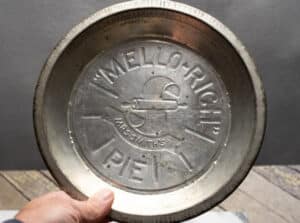
Amanda Smith started baking pies for family, friends, and charity events out of her kitchen in Pottstown, PA, but when her son, Robert Smith, convinced her to sell her pies, a business was born.
Amanda Smith was known in her community for her homey pies and generous slices. She would “use only the best ingredients. Nothing artificial, ever!”
Knowing how well-known his mother was for her pies, her youngest son Robert P. started selling slices of her deep-dish, fruit-filled pies door-to-door around 1919, and soon took over a local YMCA lunch counter that offered an “attractive and appealing variety of fruit pies and Pennsylvania Dutch specialties” baked by Mrs. Smith. Next, Robert retrofitted a delivery truck with a specially built pie cabinet and started delivering Mrs. Smith’s pies to neighborhood grocery stores and restaurants, growing their business and profits.
In 1923, when the demand for her homemade pies began to exceed the limitations of her home kitchen, Robert purchased a small store in Pottstown for their new business and purchased a commercial baking oven. In 1925, “Mrs. Smith’s Delicious Home Made Pies, Inc.” was officially formed. That same year, Amanda went into semi-retirement, turning over the new company’s pie production to her cousin, Anna C. Eimerbrink. The original Mrs. Smith never again personally baked a pie for sale.
The next big move for Mrs. Smith’s was producing frozen pies, starting in 1952, five years after Amanda’s death.
The business stayed in the hands of family members until the company went public in May 1972. In 1976, Mrs. Smith’s Pies was purchased by the Kellogg Company for $56 million. In
2003, the brand was purchased by its current owner, the Schwan Food Company.
Today, Mrs. Smith’s Pies (a.k.a. Mrs. Smith’s Bakeries) is one of the largest frozen pie brands in the United States with a 54 percent market share. In its advertising, the Company claims “Mrs. Smith’s pies are still made using Amanda Smith’s original recipes and feature her signature blue ribbon award-winning flaky crust.”

